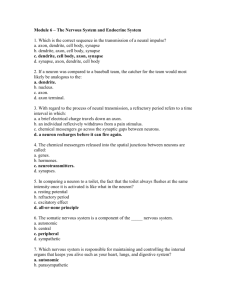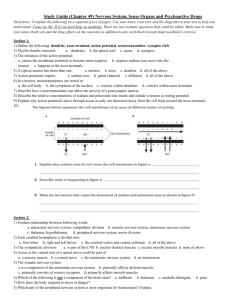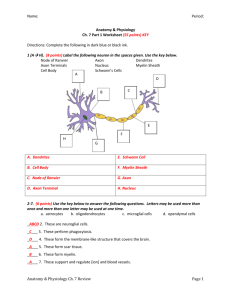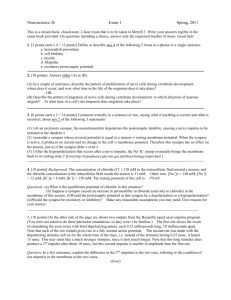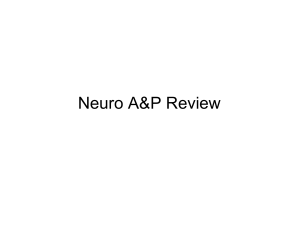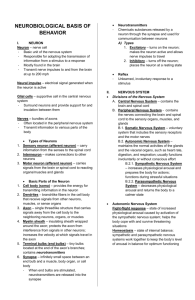Unit 9 (Animal Systems) Review KEY
advertisement
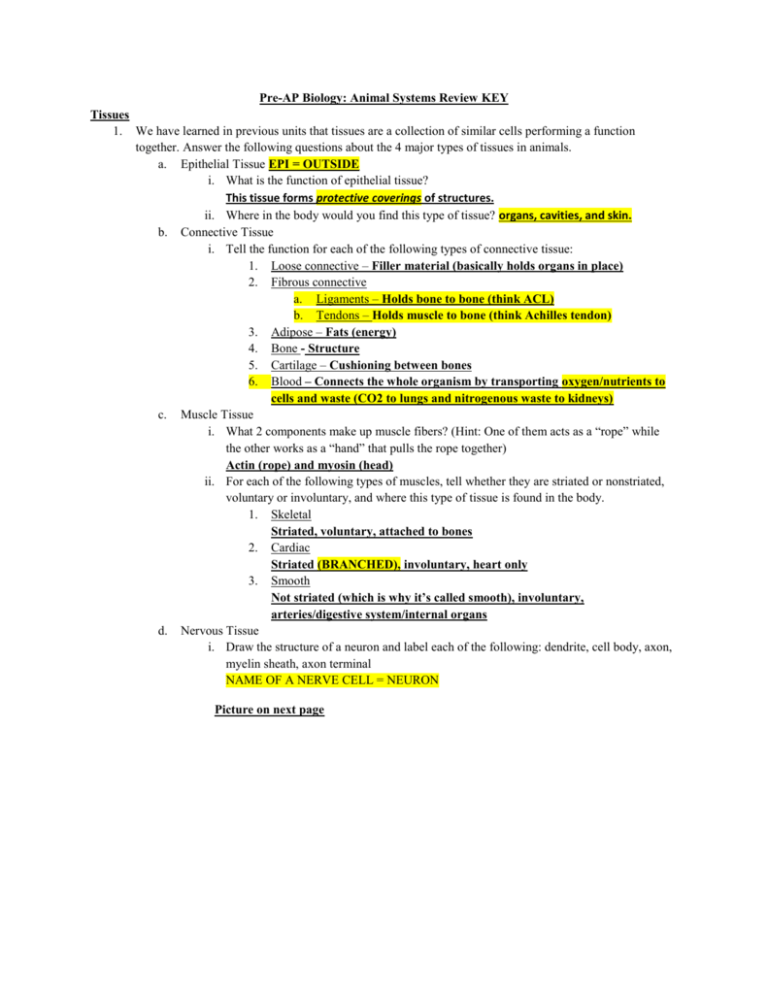
Pre-AP Biology: Animal Systems Review KEY Tissues 1. We have learned in previous units that tissues are a collection of similar cells performing a function together. Answer the following questions about the 4 major types of tissues in animals. a. Epithelial Tissue EPI = OUTSIDE i. What is the function of epithelial tissue? This tissue forms protective coverings of structures. ii. Where in the body would you find this type of tissue? organs, cavities, and skin. b. Connective Tissue i. Tell the function for each of the following types of connective tissue: 1. Loose connective – Filler material (basically holds organs in place) 2. Fibrous connective a. Ligaments – Holds bone to bone (think ACL) b. Tendons – Holds muscle to bone (think Achilles tendon) 3. Adipose – Fats (energy) 4. Bone - Structure 5. Cartilage – Cushioning between bones 6. Blood – Connects the whole organism by transporting oxygen/nutrients to cells and waste (CO2 to lungs and nitrogenous waste to kidneys) c. Muscle Tissue i. What 2 components make up muscle fibers? (Hint: One of them acts as a “rope” while the other works as a “hand” that pulls the rope together) Actin (rope) and myosin (head) ii. For each of the following types of muscles, tell whether they are striated or nonstriated, voluntary or involuntary, and where this type of tissue is found in the body. 1. Skeletal Striated, voluntary, attached to bones 2. Cardiac Striated (BRANCHED), involuntary, heart only 3. Smooth Not striated (which is why it’s called smooth), involuntary, arteries/digestive system/internal organs d. Nervous Tissue i. Draw the structure of a neuron and label each of the following: dendrite, cell body, axon, myelin sheath, axon terminal NAME OF A NERVE CELL = NEURON Picture on next page ii. Tell the function of each of the following parts of a neuron. 1. Dendrite Receive neurotransmitters from pre-synaptic neuron. Remember by dendrite = “in”drite 2. Cell Body Accumulate all the signals from dendrites into 1 action potential (NERVE SIGNAL) (this is where the nucleus is located) 3. Axon Send the action potential away from the cell body. Remember by axon=away 4. Myelin Sheath Insulation to protect your muscles as electrical signal travels down axon (like rubber covering on wires) Organ Systems: Nervous System: 1. The nervous system of all animals (no matter how simple or complex) operates by 3 basic functions that are listed below. Describe what happens in each of them. a. Sensory Input The peripheral nervous system receiving a stimulus from outside world by using your senses (sight, touch, smell, etc.) b. Integration Making “sense” of the signal received central nervous system (brain and spinal cord) c. Motor Output An action potential leaving the central nervous system to go back out to an effector cell (muscle or gland) to cause a response 2. What part of the nervous system makes up each of the following: a. Central Nervous System? b. 3. Peripheral Nervous System? Action potentials (nerve signals) travel down the axon as an electrical signal. When they reach the axon terminal, this electrical signal cannot cross the synapse (gap) to reach the next neuron. Describe the steps involved to transmit an action potential across a synapse from a pre-synaptic to a post-synaptic neuron, and how the postsynaptic neuron then continues the signal. Be sure to use the following terms in your description in this exact order (they’re listed as they would occur): presynaptic neuron, axon, axon terminal, synapse, neurotransmitter, vesicle, postsynaptic neuron, dendrite, cell body. 1) An electrical impulse called an Action Potential travels down the axon of the presynaptic neuron. 2) The Action Potential cannot cross the synapse (gap) at the axon terminal; therefore, vesicles containing a chemical messenger called a neurotransmitter fuse with the axon membrane. 3) These vesicles containing the neurotransmitter are released into the synapse in order transmit the information from one neuron to the next. 4) Dendrites of the postsynaptic neuron receive these neurotransmitters and each dendrite relays this information to the cell body. 5) The cell body translates this chemical information into an electrical Action Potential which is sent down the axon. 6) This process repeats itself as a nerve signal is sent to and from the brain and various locations in the body. 4. 5. Why does a reflex (reflex arc) happen faster than a normal response? The spinal cord integrates the information instead of the brain (so the signal returns faster since it didn’t have to go to the brain) Describe the location and function of each of the following lobes of the brain: a. Frontal It is concerned with emotions, reasoning, planning, movement, and parts of speech. It is also involved in purposeful acts such as creativity, judgment, problem solving, and planning. It is the “human” part of the brain. b. c. d. 6. Parietal Senses (touch, pain, taste, pressure, temperature) Occipital Vision Temporal Hearing and memory The cerebellum is not a lobe of the brain but plays a very important role in its function. Describe the function of the cerebellum. It incorporates information from all lobes to allow for coordinated movement of skeletal muscle system Endocrine System: 1. The nervous system provides immediate control over muscle function and other important systems. The endocrine system provides long-term control of other organ systems through the production of hormones. What is a hormone, and what is its function? This is a chemical produced in one part of the body and travels to another part of the body to have an effect. THIS IS RESPONSIBLE FOR LONG TERM CONTROL OF OTHER SYSTEMS 2. Hormones regulate other systems through negative and positive feedback loops. Describe each of the following: a. Negative feedback loop If a process gets too high, a negative feedback loop will bring it back down. If a process gets too low, a negative feedback loop will bring it back up. MAINTAINS HOMEOSTASIS THINK THERMOSTAT b. Positive feedback loop Positive feedback loops push a process even further in the direction it is going. THINK CHILD BIRTH 3. What is the general name for anything that produces a hormone (and thus is part of the endocrine system? gland 4. Describe the function of the following 3 major parts of the endocrine system: a. Hypothalamus gland - This is the master control gland of homeostasis. b. Pituitary Gland - This is the second in charge in control of homeostasis. c. Pancreas i. Releases glucagon to raise blood glucose levels ii. Release insulin to lower blood glucose levels Circulatory System: 1. What is the purpose of the circulatory system? Connects the whole organism by transporting oxygen/nutrients to cells and waste (CO2 to lungs and nitrogenous waste to kidneys) 2. Draw a simple diagram of a heart and label the 4 chambers. Beside each chamber, tell whether it receives or pumps blood as well as whether it contains oxygenated or deoxygenated blood. 3. What is the function of each of the following type of blood vessels? a. Arteries b. Arterioles c. Capillaries d. Venules e. Veins Picture on next page 4. Describe the flow of DEOXYGENATED BLOOD as it returns to the heart until it eventually leaves the heart as OXYGENATED blood to be pumped to the rest of the body. In your description, use the following terms: Inferior/Superior Vena Cavae, Deoxygenated, Left Atrium, Right Atrium, Left Ventricle, Right Ventricle, Pulmonary Artery, Lungs, Pulmonary Vein, and Aorta a. Deoxygenated (no oxygen) blood returns from all parts of the body through the Inferior and Superior Vena Cavae. All veins empty into these “major veins”. b. This blood flows into the right atria. c. From here it goes to the right ventricle where it is pumped to the lunges through the pulmonary artery to get oxygen. d. Oxygenated blood returns to the left atria through the pulmonary vein. e. The blood then goes to the left ventricle where it is pumped to the entire body through the aorta. Respiratory System: 1. We breathe in to get oxygen and breathe out to get rid of carbon dioxide. What is the PURPOSE of each of these in cellular respiration? Oxygen is the final acceptor in the Electron Transport Chain (so allows more ATP to be made). CO2 is the waste product from breaking down glucose (C6H12O6) *** NOTE THAT CO2 AND O2 DO NOT BECOME ONE ANOTHER 2. Below is the order of structures that air passes through as it travels from the external environment to the lungs where gas will be exchanges (CO2 released and O2 picked up). For each part, tell where it is located and its function. a. Nasal Cavity Nostrils; Bringing in air from the external environment and cleaning/moistening the air. b. Larynx Voice box at which is at the top of the trachea. REMEMBER BY LARYNX = LOUD c. Pharynx Throat; Divides into 2 tubes (trachea to the lungs and esophagus to the stomach) i. Epiglottis – cover the trachea when the epiglottis when you swallow so that food doesn’t go into your lungs ii. REMEMBER BY PHARYNX=PART d. Trachea Windpipe; Taking air to the lungs; Remember as “trachea=talk” Bronchi The trachea branches into 2 tubes call bronchi that go to the 2 lungs Bronchioles Each of the 2 bronchi branch into bronchioles at they cover the inside of the lungs Alveoli The end of each bronchiole. It is a very thin membrane surrounded by capillaries where CO2 is taken from the lungs and exhaled from the body. This is also where O2 from the external environment enters the blood. e. f. g. Digestive System: 1. We eat food in order to get carbohydrates and triglyceride. We convert the energy in this food to power cellular respiration. a. What is the name given to the process of chemical converting the energy in our food to build ourselves up? metabolism b. What molecule is made using the energy from our food that is used to power all process in our body? ATP 2. Below is the order of structures food passes through as it travels through our body. For each part, tell where it is located and its function. a. Mouth/Teeth (obviously you know where this is located. What is its function) – Mechanical breakdown of food (tearing it into smaller pieces so it can be digested easier). Also, saliva begins the digestion process b. Pharynx – Throat; Divides into 2 tubes (trachea to the lungs and esophagus to the stomach) c. Esophagus – Tube leading to the stomach. Remember as esophagus=eat d. Stomach – Chemical breakdown of food (hydrolysis) e. Small intestines – Reabsorption of nutrients back into the blood to be distributed to the rest of the body f. Large intestines – Reabsoprtion of water back into the blood g. Anus – Expel waste from food (all the material not reabsorbed back into the blood) *** Not on your paper: Liver, Gallbladder, Pancreas Urinary System: 1. What is the purpose of the urinary system? Expel nitrogenous waste 2. What is the name of a kidney cell? nephron 3. Each of the following structures are involved in the urinary system. Describe the function of each. a. Renal Artery Takes blood (with all its waste) to the kidneys (remember arteries = away from the heart) b. Renal Vein Takes blood away kidneys back toward the heart c. Ureter Tube leading from the kidneys to the bladder d. Urethra Tube leading from the bladder to outside of the body e. Kidney Purifies blood by removing nitrogenous waste f. Bladder Holds urine before it is expelled from the body Immune System: 1. What is the purpose of immune system? Protect the body from pathogens 2. Innate immunity the immunity you have at birth. It provides general protection against most organisms and environmental hazards. Tell how each of the following components of the innate immune system provide protection for the body. a. Skin – keep pathogens from entering the entire body b. Mucous membranes – keep pathogens from getting into the body through the nasal passage c. Saliva – kill bacteria in the mouth d. Tears – keep pathogens from getting into the body through the eyes e. 3. 4. Phagocytes – Phage means “eat”. They are general eaters that digest any foreign invader that’s in the body. They know that it is not supposed to be in the body by checking its glycoproteins. Your specific immunity protects against the attack of specific pathogens using the Lymphocyte white blood cells. (These are like specialized assassins.) Tell the function of each of the following. a. B Cells Clean the blood of SPECIFIC pathogens that have been analyzed by helper T cells b. Cytotoxic T Cells Kill cells that are infected with a pathogen after the pathogen has been analyzed by helper T cells c. Helper T Cells Analyze the pathogen after it is presented by the phagocytes. (AIDS) d. Memory B and Memory T cells After the body fights off a pathogen the 1 st time, memory B and T cells are made so that the next time the pathogen gets into the body it can be fought off faster. This is why vaccines work. You get a cut in your skin and bacteria gets into your body. Describe the process to rid yourself of the bacteria (and protect yourself against future invasion from the same pathogen). Use the following terms in your description: Phagocytes, Glycoprotein, Helper T Cell, B Cell, Cytotoxic T Cell, Memory B Cell, Memory T Cell USE STYROFOAM VIRUS TO DEMONSTRATE 1. Pathogen breaks through innate response. 2. Phagocytes recognizes it is an invader by checking its Glycoproteins. The phagocyte digests the pathogen and presents it. 3. Helper T cell reads it and tells the body what type of B and Cytotoxic T cells to make. 4. Cytotoxic T cells kill the infected cells so they don’t spread. 5. B cells clean the blood of any of the leftover pathogen. 6. Memory B and T cells are made to fight the pathogen if it gets into the body again. Reproductive 1. What is the purpose of this system? make haploid gametes through meiosis 2. Tell the function of each of the structures involved in the reproductive system? a. Female reproductive organs i. Ovary – productive of haploid egg ii. Fallopian tube – passageway for egg from ovary to uterus iii. Uterus – site of implementation of zygote if egg is fertilized (baby will grow here) iv. Cervix – opening of uterus from vagina v. Vagina – organ for sperm entry to begin reproduction b. Male reproductive organs i. Testicles – Production of sperm ii. Scrotum – Keep testicles from being held inside the body (because the 98.6 degree temperature of the human body would kill the sperm) iii. iv. v. vi. Epididymis – stores sperm after produced by testicles Urethra – carries urine and sperm outside of the body Prostate gland – secretes additional fluid into semen to nourish sperm Penis – male reproductive organ

